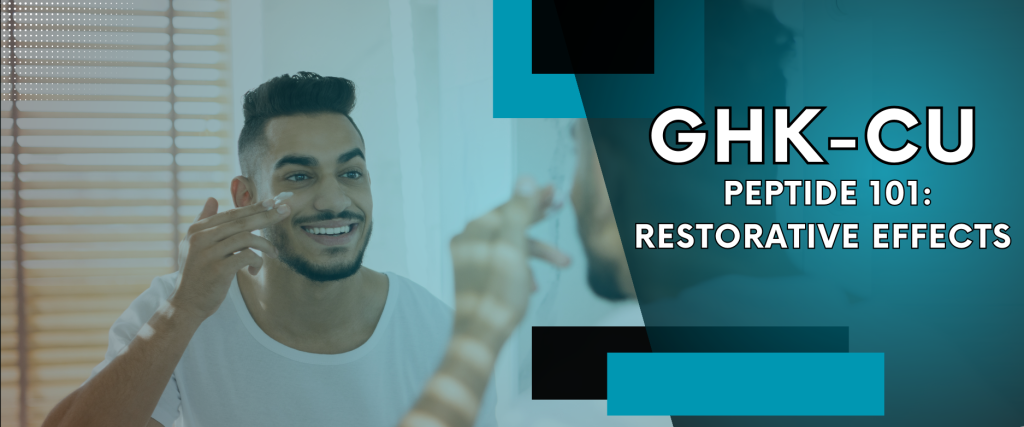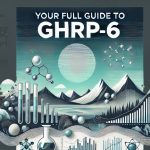GHK-Cu, also known as the copper peptide, is a peptide commonly found in naturally occurring substances in your body such as plasma, saliva, and urine.
This peptide is most commonly found in adults aged 25 and younger when their tissues are at their peak potential but slowly declines as time goes on as you age.
With this in mind, this peptide is especially popular in both the anti-aging and skincare space as it has been shown to promote collagen production, improve skin elasticity, and reduce the appearance of wrinkles and fine lines.
Hopefully, this article will serve as a reference guide in anything GHK-Cu-related every time you use it for research.
Let’s get started.
What is GHK-Cu?
GHK-Cu comprises only three amino acids in this order: glycine, histidine, and lycine — forming a glycyl-histidyl-lysine chain. This is an important part to take note of as this sequence forms a tripeptide chain.
Now, the histidine in this chain has a particular ring structure coined as the “imidazole ring” which allows it to have a high affinity for binding with copper(II) ions, which then forms GHK-Cu.
Due to this unique structure, GHK-Cu is small in size which can easily interact and deliver non-toxic copper into our cells – essential for various functions commonly associated with healing like BPC-157, which may understandably confuse some people.
However, what’s pretty remarkable about GHK-Cu is that it’s been scientifically proven by a study to successfully increase your body’s total gene expression by about 31.2%.
In this context, “gene expression” is the process in which genetic information is used to produce proteins or other molecules.
GHK-Cu influences how much of your proteins or molecules are made from specific genes. That’s right, GHK-Cu can alter various biological processes such as healing, inflammation, and cellular communication – and improve it.
According to the same study, GHK-Cu can:
- tighten loose skin
- reverse aged skin thinning
- repair protective skin barrier proteins
- improve skin firmness elasticity and clarity
- reduce fine lines, depth of wrinkles and improve structure of aged skin
- smoothen rough skin
- improve overall skin appearance
- stimulate wound healing
- protect skin cells from UV radiation
- reduce inflammation and free radical damge
- increase hair growth and thickness through enlarging hair follicle size
Stimulates Skin Repair
As we age, our skin’s ability to repair itself tremendously declines. Studies attribute this to declining GHK in our plasma. According to the same study, we have about 200ng/mL (nanograms per liter) of GHK at age 20. However, it declines to 80ng/mL once we hit 60.
After age 20, we enter a phase called “intrinsic aging” wherein our bodies naturally produce less and less collagen each year. This can manifest as wrinkles or sagging skin.
However, GHK-Cu may be able to rejuvenate tissues and increase collagen production in a number of ways:
- One study found that GHK-laden plasma taken from young subjects caused old liver tissue in older subjects to produce proteins that behave like those of the younger subjects.
- GHK-Cu also has a hand in stimulating our fibroblasts– this is important as fibroblasts are cells that produce several growth factors beneficial for skin repair.
According to an in-vitro study (in-vitro meaning glass) published in 2007, GHK when combined with an alternative treatment option called red light therapy, increased basic fibroblast growth factor (bFGF) by 230% and collagen synthesis by 70%.
- In another older study conducted during the 1980s, it has been observed that GHK is released when something damages our skin and regulates our matrix metalloproteinases (MMP).
In simpler terms, MMPS are enzymes that break down excess collagen and elastin. GHK helps regulate this behavior, improving skin regeneration and even preserving our skin structure.
Promote Wound Healing
In animal studies, GHK-Cu has been shown to exhibit angiogenetic and anti-inflammatory properties, which could accelerate wound healing.
In rabbit models, topically-administered GHK alone improved wound contraction, increase activity of antioxidant enzymes, and promote angiogenesis throughout the body.
In rat models, GHK-Cu, when administered through a collagen dressing can improve and even accelerate wound healing in both healthy and diabetic rats.
In the diabetic rats, results show about higher levels of glutathione (another peptide), ascorbic acid, collagen production, improved epithelialization (a process where cells migrate to the wounded area) and fibroblast activation.
For the healthy rats, however, the treatment had gone way better than expected as they increased 9x the collagen – this is mindblowing as these may suggest that we can expect similar results in human trials.
Furthermore, in another study conducted with rat models, wounds treated with GHK-Cu displayed faster healing, decreased MMP concentration, and reduced inflammation when compared to untreated wounds.
Anti-Oxidant and Anti-Inflammatory Properties
GHK-Cu has also been shown to exhibit both antioxidant and anti-inflammatory properties in animal models. This is great news as elevated levels of these factors can help potentially reduce skin redness, swelling, or irritation in future clinical trials.
Furthermore, increased antioxidant enzymes can possibly help protect our skin from damage caused by free radicals. In simpler terms, free radicals are unstable molecules that can damage the cells and contribute to our aging.
There are quite a number of studies in this area, so we’ll condense it all in bullet form for better clarity:
- Block the effects of lipid peroxidation, a process where free radicals directly attack and degrade cell membranes, propagating oxidative stress, impairing mitochondrial function, inducing inflammation, and causing DNA damage — all of which contribute to aging.
- Block low-density lipoproteins (LPL), also known as bad cholesterol, contribute to aging by promoting inflammation, cellular damage, and oxidative stress.
- Reduce the amount of iron released from ferritin by 87%. Ferritin is a protein that, when introduced in blood plasma, can cause lipid peroxidation.
Encourage Hair Growth
While the number of conclusive studies is limited in this benefit, one study suggests that GHK-Cu can encourage hair growth in animal experiments.
In this study, the researchers theorized that GHK-Cu can theoretically promote hair growth by stimulating the fibroblasts to produce more vascular endothelial growth factor (VEGF). This helps promote blood vessel formation around hair follicles, improving our blood and nutrient circulation in the scalp.
To test this out, the researchers used an ionic liquid microemulsion to improve administration. This is a mixture of droplets suspended in another substance. Think of it as oil droplets in a bucket of water.
Results show that hair follicles began to grow in as early as 6 days, exhibiting hair regrowth and hyperpigmentation.
After 28 days, the number of hair follicles observed in the treatment group was significantly more numerous and denser than the control group, with the follicles even reaching down to the subcutaneous tissue.
Researchers also discovered that the collagen fibers in the treatment group were more closely arranged and had better organization when compared to the control group. This is important as collagen fibers are what make hair tough and tension-resistant.
This is an interesting study as it also claims that the performance exhibited by the GHK-Cu mixture was even better than the commercially available minoxidil.
For context, minoxidil can promote hair growth by expanding the blood vessel networks in our scalp, improving blood and nutrient circulation. However, this drug can negatively affect our cardiovascular system and cause increased heart rates.
GHK-Cu Side Effects
As with any peptides, GHK-Cu has some side effects to take note of. However, this happens rarely and we believe the benefits heavily outweigh the side effects.
Common side effects may include:
- People with sensitive skin may experience skin irritation through allergic reactions. This can manifest through redness, itching, rashes, or discomfort.
- In very rare overuse cases, GHK-Cu can cause copper imbalance, which can cause oxidative stress and skin damage. One workaround to this side effect is to let your subject take zinc supplements to balance each other out.
- Skin discoloration due to GHK-Cu reacting with other ingredients in certain formulations. This may also result in reducing its effectiveness or cause unexpected side effects.
Known Administration Methods
GHK-Cu can be administered either topically or subcutaneously – the former being the most popular option for researchers. This peptide is often included in typical skincare products such as moisturizing creams that provide hydration, and serums that penetrate deeper into the skin.
However, there are some downsides to this administration method:
- The copper element in GHK-Cu can have high reactivity and sensitivity to pH, antioxidants, chelating agents, etc., which are all commonly present in skincare products.
- GHK-Cu is hydrophilic and the skin may not fully absorb it when applied topically. In some studies, about 95% of the peptide is excreted by the body.
Thankfully, GHK is also available in lyophilized form for subcutaneous injections, which help maximize its efficacy.
For dosages, we don’t have a particular recommendation – but according to sources we found online, dosages can vary from 2-3mg reconstituted with 1ml BAC water per day.
However, we highly recommend consulting with a certified health professional about your dosages for research first.
Verdict
While GHK-Cu can be considered a small peptide, it possesses a staggeringly wide range of health benefits, and emerging studies are still revealing more of its effects in both animal and human studies.
If you’re a researcher focused on longevity, GHK-Cu’s anti-aging and antioxidant properties may be up your alley just like this researcher:
However, the changes are not something you can clinically see as they work on a cellular level and each of us has a unique physiology – you may not feel subtle changes to your body, but that doesn’t necessarily mean it’s all snake oil.
GHK-Cu, when used correctly, works amazingly well, but what is proven to work in some studies may not necessarily apply to your research subject.
As always, we highly recommend discussing this with a physician before you use this peptide as as individual responses to treatments can vary.
If you loved this article and have some questions we haven’t covered, don’t hesitate to leave a comment down below!
FAQs
How much GHK Cu should I take?
As mentioned before, we don’t have a particular recommendation as dosages vary depending on the study. However, according to what we found online, researchers use 2-3mg reconstituted with BAC water per day.
How to mix GHK Cu?
To mix GHK-Cu, we would have to use its proper term; peptide reconstitution. In this process, we’ll take a lyophilized peptide (GHK-Cu in powder form) and turn it into a liquid for injection.
To do this, you are going to mix a proper dose of the powder in either sterile or bacteriostatic (all up to your preference). For more detailed instructions, we recommend you check out our peptide reconstitution guide.
How to inject GHK Cu peptide?
You can inject GHK-Cu in just about anywhere in your subject’s body as it’s systemic.
For example, if your subject has an injury in their back, you can inject it in the belly and it will still work as intended. 👍
Where to buy GHK Cu for sale?
https://www.facebook.com/groups/sarms.peptides.nootropics/permalink/1170950600427002
It’s legal to purchase GHK-Cu for research studies, but NOT for human consumption or cosmetic use without proper licensing and oversight.
With that said, you can buy GHK-Cu in the form of topical creams or supplements in most online cosmetic stores.
For its lyophilized form, you can get it through compounding pharmacies or online research compound sellers. They usually come in labeled as “GHK-Cu 50mg” vials.
We particularly like sourcing ours from Royal Research as they have been consistently delivering us peptides with high purity. They even bother doing 3rd-party HPLC testing on their end, too.
You can use our referral link (rc10) to get 10% off your next purchase.







